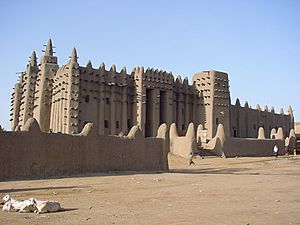Trans-Saharan trade facts for kids
The Trans-Saharan trade was a huge network of trade routes that crossed the vast Sahara desert. People traveled across this desert to connect North Africa with lands south of the Sahara, often called sub-Saharan Africa. This trade also linked North Africa to places like Europe and the Middle East. It was a way for different cultures to exchange goods, ideas, and even people. This ancient trade started in very old times and became super important from the 700s AD until the late 1500s.
Contents
What Was the Trans-Saharan Trade?
The Trans-Saharan trade was like a giant highway system, but instead of roads, it was made of desert paths. These paths connected towns and cities across the Sahara Desert. Imagine merchants traveling thousands of kilometers, carrying valuable items. They used these routes to move goods between the northern parts of Africa and the regions below the Sahara. This trade helped different societies grow and connect with each other.
Why Was This Trade Important?
This trade was very important for many reasons. It helped powerful empires and kingdoms grow in both North and West Africa. Cities like Timbuktu and Djenné became rich and famous because they were major stops on these trade routes. The trade also helped spread new ideas, religions like Islam, and technologies across the continent. It created a strong link between different cultures.
What Was Traded Across the Sahara?
Many different goods were carried across the desert. One of the most important items traded was gold. West African kingdoms had a lot of gold, which was highly valued in Europe and the Middle East. Another very important item was salt. Salt was needed to preserve food and was scarce in many parts of West Africa. People would trade gold for salt, almost pound for pound.
Other goods included:
- Textiles: Cloth and fabrics from North Africa.
- Slaves: People were also traded as laborers.
- Food: Dates, grains, and other food items.
- Crafts: Pottery, tools, and other handmade goods.
- Animals: Camels were essential for travel, and sometimes other animals were traded.
How Did Traders Cross the Desert?
Crossing the Sahara was very difficult and dangerous. Traders used camels because these animals are perfectly suited for desert travel. Camels can go for long periods without water and carry heavy loads. Groups of traders would form large caravans to travel together for safety. These caravans could have hundreds or even thousands of camels.
The journey could take many weeks or even months. Traders followed specific routes that connected oasises. Oases were like rest stops in the desert, with water and sometimes food. Experienced guides, often Berbers or Tuaregs, led the caravans. They knew the desert paths and where to find water.
When Did the Trade Flourish?
The Trans-Saharan trade existed for a very long time, even in ancient times. However, it became very busy and important starting around the 8th century AD. This was when the Arab conquests helped connect North Africa more closely with the Middle East. The trade continued to be strong for many centuries.
It started to decline in the late 16th century. This happened because new sea routes were discovered. European explorers found ways to sail around Africa, making it easier and cheaper to transport goods by ship. This meant that traders no longer needed to cross the dangerous Sahara desert as much. Even though it declined, the Trans-Saharan trade left a lasting impact on the history and cultures of Africa.
Images for kids
-
A building in Oualata, southeast Mauritania
-
The Bilma oasis in northeast Niger, with the Kaouar escarpment in the background
-
Modern-day camel caravan near the Ahaggar Mountains in the central Sahara, 2006
-
Saharan trade routes circa 1400, with the modern territory of Niger highlighted
See also
 In Spanish: Comercio transahariano para niños
In Spanish: Comercio transahariano para niños






